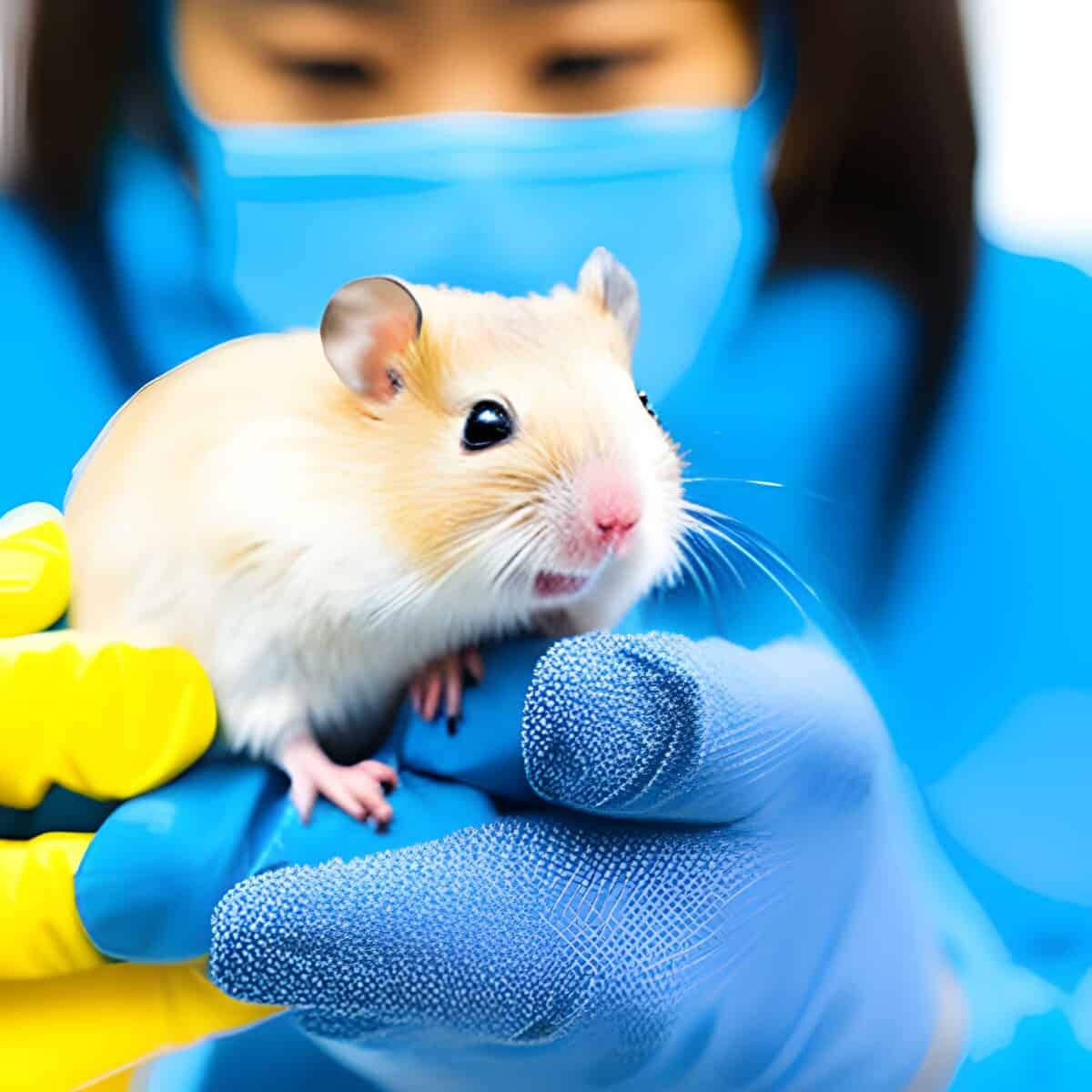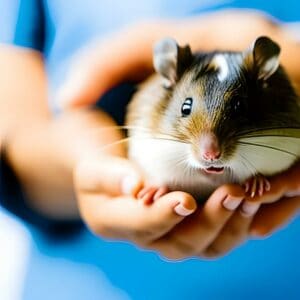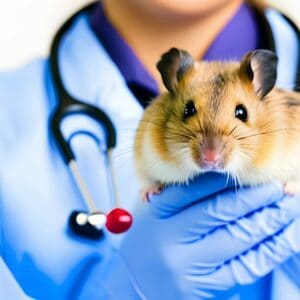Hamsters bring joy and companionship to our lives as members of our families.
Sadly, as much as we love them, we must also be prepared to face the difficult reality of a hamster’s declining health issues and eventual passing.
Hamster dying process is a complex and often gradual process that leaves us enough time to take action and help them feel comfortable and loved.
This guide is dedicated to hamster owners and will include signs and symptoms of the process, advice on coping and care, and our vet’s answers to common questions.
We will also address the emotional aspect of coping with the loss of a hamster and offer guidance on navigating the grieving process.
Hamster Dying Process: Table of Contents
Signs your Hamster is in the dying stage
Hamsters are good at hiding their discomfort and pain, but the most common signs a hamster is dying include:
Changes in Appearance
If you notice any sudden changes in your hamster’s appearance, such as:
- patches of hair loss
- rough skin
- dull coat
these changes can be an indication of an underlying health issue, and if left untreated, they might lead to the death of your pet.
A healthy hamster’s coat should be soft and shiny, and its skin should look healthy without any signs of redness or irritation.
Behavioral Changes and Posture
A hamster nearing the end of its life may exhibit abnormal behavior and posture.
It may appear disoriented, confused, or restless. In some cases, a hamster may assume unusual positions or struggle to maintain a balanced posture.
If your hamster suddenly becomes less active, refuses to play or interact with toys or has difficulty moving, it could be an indication of illness or injury.
Other behavioral changes to take note of include:
- sudden aggression
- disorientation
- lethargy
A healthy hamster is usually active and playful, and they enjoy running on their wheel or exploring their cage.
Loss of Appetite
One of the first signs that a hamster may be approaching the end of its life is a significant loss of appetite.
Alongside this loss of appetite, you may notice increased lethargy and a lack of energy in your hamster.
A hamster that stops eating is a cause for alarm.
A hamster that refuses food or water for an extended period can lead to severe dehydration and malnutrition, ultimately leading to its demise.
If you notice any changes in their eating habits, it’s crucial to seek medical attention immediately.
Changes in Activity Level
A dying hamster may become less active and spend more time sleeping or resting.
Activities that it once enjoyed, such as playing on its exercise wheel or exploring its surroundings, may diminish or cease altogether.
Difficulty Breathing
If you notice your hamster is struggling to breathe or making strange noises, it could be an indication of respiratory issues that affect the hamster’s lifespan drastically.
Respiratory infections are prevalent in hamsters and are one of the leading causes of death.
A healthy hamster should breathe normally without any difficulty or strange noises. If you notice any changes in their breathing, it’s crucial to seek medical attention immediately.
Labored breathing or irregular breathing patterns can indicate that a hamster’s health is deteriorating. Wheezing, gasping for air, or rapid, shallow breaths are signs of respiratory distress and should not be ignored.
Physical Symptoms of Illness or Injury
Physical symptoms such as sores, wounds, or visible injuries should not be overlooked.
Any sudden changes in the hamster’s physical condition, including lumps, growths, or changes in fur texture or color, may indicate an underlying health issue.
Deterioration of Fur and Skin Condition
A dying hamster may experience a decline in its fur and skin condition.
Its fur might become dull, matted, or unkempt. Similarly, the hamster’s skin might appear dry, flaky, or irritated.
Inability to groom itself
Hamsters are generally diligent groomers, and a noticeable decrease in grooming behavior can indicate that they are not feeling well or are experiencing discomfort.
When a hamster is unable to groom itself, it may be due to physical weakness, pain, or other underlying health issues. In some cases, hamsters may be too weak or lethargic to perform grooming activities on their own.
This can manifest as a matted or unkempt coat, overgrown nails, or an overall disheveled appearance.
When grooming changes are combined with other signs such as loss of appetite, weight loss, decreased activity, and other physical symptoms, it may indicate that the hamster’s health is declining.
Eye and Nose Discharge
Excessive eye or nose discharge, particularly if it is thick, discolored, or foul-smelling, could be a sign of infection or illness in a hamster.
Pay attention to any unusual secretions and seek veterinary advice.
Weight Loss
Unexplained weight loss is a common indicator of declining health in hamsters. If your hamster is losing weight despite a consistent diet, it may be a sign that its body is no longer functioning optimally.
Dehydration
A hamster’s hydration status is vital for its well-being. If you notice signs of dehydration, such as sunken eyes, dry mouth, or lethargy, talk to the vet.
Changes in Waste Production
Alterations in the hamster’s urinary or fecal patterns can provide insight into its health condition. Be observant of any significant changes in waste production, such as unusually small or infrequent droppings, blood in the urine or feces, or diarrhea.
Seizures or Twitching
In some cases, a dying hamster may experience seizures or twitching movements. These involuntary muscle contractions can be distressing to witness, but it’s important to remain calm and seek professional advice.
Inability to Move or Stand Properly
Hamsters might have difficulty moving, climbing, or even maintaining its balance. This loss of coordination can be indicative of a serious underlying health issue.
Loss of Balance and Coordination
Hamster might stumble or fall frequently, unable to navigate its environment as it once did.
Deep sleep
Hamsters are known to enter a state of deep sleep called torpor, which can resemble hibernation.
During torpor, a hamster’s breathing may become extremely shallow, and it may appear unresponsive or less active.
Deep sleep alone does not necessarily mean a hamster is dying. However, in conjunction with other signs such as loss of appetite, weight loss, lethargy, and other physical symptoms, it may indicate that the hamster’s health is deteriorating.
Vocalizations and Communication Changes
It may vocalize differently, produce unusual sounds, or have difficulty communicating with its owners.
Hiding or Seeking Isolation
They might retreat to secluded areas of their habitat or create nests in secluded corners.
Hamsters are capable of hibernating under certain conditions, and it’s important to differentiate between hibernation and the dying process. Here are some key points to consider:
Hibernation vs Dying: What is the difference?
Hibernation in Hamsters:
Hamsters, particularly Syrian hamsters do not hibernate under typical conditions but can enter hibernation if environmental conditions require it.
Hibernation occurs when the ambient temperature drops below 65 degrees Fahrenheit for an extended period.
This triggers a slowed metabolic rate in hamsters, making them appear dormant.
During hibernation, hamsters consume less food and water and lower their body temperature to conserve energy.
Breathing rates may be slow in hibernating hamsters, with intervals of 1 breath every 2-3 minutes.
Dying Process in Hamsters:
The dying process in hamsters may exhibit signs such as loss of appetite, weight loss, decreased activity, and other physical symptoms.
Inability to groom, physical weakness, and a disheveled appearance can be indications that a hamster’s health is declining.
If a hamster is dying, it may not respond to stimuli and may show a lack of energy or movement.
Differentiating between hibernation and the dying process in hamsters can be challenging. However, a veterinarian can provide a proper diagnosis based on a comprehensive examination of the hamster’s condition.
They can evaluate vital signs, assess responsiveness, and consider the environmental factors to determine the most likely explanation for the hamster’s condition.
How Can Vets Help with Hamster Dying Process?
If you observe any of the mentioned signs or suspect that your hamster is nearing the end of its life, veterinarians with experience in small animal care can:
- provide a thorough examination
- offer a diagnosis
- suggest appropriate treatment options if available
- help you navigate the process
- offer tips and advice on how to handle the hamster and what to expect
Remember, professional guidance helps you and your hamster receive the best possible care during this challenging time.
What Can You Do During Hamster Dying Process?
Create a Calm Environment
Reduce exposure to loud noises, bright lights, or other stress-inducing stimuli. A peaceful environment can help alleviate any unnecessary anxiety or discomfort.
Adjust the Hamster’s Habitat
Hamsters are sensitive to temperature changes and drafts, so it is important to keep their environment warm and dry.
You can add additional blankets or heating pads to help keep them comfortable. However, be sure not to overheat them, as this can cause more harm than good.
You can also add a cozy hiding spot, such as a small box or a hamster igloo, to make them feel safe and secure.
They need easy access to food and water.
Consider lowering or removing high platforms or obstacles that could pose a risk to a weakened hamster.
Maintain Hygiene
Regularly clean the hamster’s habitat, including the bedding, toys, and food/water containers, to prevent the buildup of bacteria and ensure a hygienic environment.
Nutrition and Hydration
As your hamster’s energy levels decrease, they may lose their appetite.
Offer soft, moist foods, such as cooked vegetables or fruits, to keep your hamster hydrated.
You can also offer fresh water in a shallow dish or a water bottle.
If they refuse to eat, you can try hand-feeding them or offer high-calorie foods such as baby food or honey water to keep their energy levels up.
However, it is important to consult with a veterinarian before making any changes to your hamster’s diet.
Offer easily digestible and nutritionally balanced food options to encourage your hamster to eat.
Monitor the Hamster’s Condition
Keep track of any changes or developments.
Keep a record of its eating, drinking, and waste production patterns, as well as any concerning symptoms. This information will be valuable when discussing the hamster’s condition with your veterinarian.
As your hamster’s health declines, they may require additional medical care or pain management. A veterinarian can help you determine the best course of action for your hamster’s health.
Handle Your Hamster Gently
Minimize unnecessary stress and do not disturb them too often by picking them up unless necessary.
If your hamster feels better and enjoys being in your arms you can consider using a soft, warm cloth to hold them.
Medications and Treatments
If your veterinarian prescribes medications or treatments to alleviate discomfort or manage symptoms, follow their instructions.
Provide Emotional Support
Spend quiet moments with your hamster, speak softly, and offer gentle strokes if it is receptive. Your soothing presence can bring comfort to a hamster in its final days.
How to Cope with Hamster Dying Process?
Even just thinking of losing a beloved hamster can be an emotionally challenging experience.
It is a misconception that vets treat different pets with more or less compassion. If you feel like you are not getting enough support during this time – I m so sorry.
What you need to understand is that, unfortunately, vets face dying processes daily and sometimes they may seem less affectionate. Regardless, they will and should offer the best possible care.
Both, owners and hamster are going through this process, so here are some advice we share with owners that are going through the loss of their hamster:
Allow yourself to express the grief
It is natural to feel sadness, and it’s important to acknowledge and express your emotions. Share your feelings with understanding friends or family members who can provide comfort and support during this time.
Share Memories
Share and reminisce about the memories you created with your hamster. Look at photographs, write about your experiences together, or create a memorial to honor its life. Keeping the memories alive can be a source of comfort and solace.
TakeCare of Yourself
Take care of your own well-being during the grieving process. Engage in self-care activities that bring you comfort, such as spending time in nature, practicing relaxation techniques, or pursuing hobbies that bring you joy.
Seek Support
Reach out to support groups or online communities where you can connect with people who have experienced similar losses. Sharing your thoughts and feelings with others who understand can be helpful in the healing process.
Honor Your Hamster’s Legacy
Plant a tree or flowers in its memory, create a memorial plaque or artwork, or make a donation to a hamster rescue or charity in its name. Finding meaningful ways to commemorate your hamster can provide a sense of closure and honor its impact on your life.
Common Health Issues in Hamsters

Wet Tail
Wet tail is a bacterial infection that can affect hamsters of all ages.
It’s caused by stress, poor hygiene, or a diet that’s high in sugar.
This infection is characterized by diarrhea, a wet appearance, and an unpleasant smell.
If left untreated, it can lead to severe dehydration and can be fatal to your pet. To prevent a wet tail, your hamster’s cage needs to be clean and dry at all times.
Also, avoid feeding your pet sugary treats and ensure that they have access to clean water at all times.
Respiratory Infections
Respiratory infections are a common problem in hamsters, and it’s caused by various environmental factors, including poor ventilation or exposure to dirty bedding.
Symptoms of respiratory infections include difficulty breathing, lack of energy, sneezing, and wheezing.
To prevent respiratory infections, your hamster’s cage needs to be clean and well-ventilated. Also, avoid using dusty bedding and ensure that your pet is not exposed to cigarette smoke.
Tumors
Tumors can affect hamsters from an early age, and they can occur anywhere in the body.
Small tumors may not cause any issues, but larger ones can cause discomfort and may affect the hamster’s mobility and other bodily functions.
Tumors can be benign or malignant, and they require prompt medical attention. To prevent tumors, ensure that your hamster’s cage is clean and well-maintained. Also, ensure that your pet has a healthy diet and gets enough exercise.
Dental Problems
Dental problems are prevalent in hamsters, and they can cause various complications with feeding and other aspects of their daily life.
Common dental problems include overgrown or misaligned teeth, which require special attention and treatment.
To prevent dental problems, your hamster’s diet should be rich in fiber and not sugary treats.
Also, provide your pet with chew toys to help keep their teeth healthy and strong.
Vet Q&A
Q: How can I tell if my hamster is dying?
A: Signs that might indicate a hamster is in the process of passing away include loss of appetite and thirst, deep sleep, extremely shallow breath, inability to groom, and rapid weight loss.
Q: How long does the dying process of a hamster last?
A: The actual dying process can take days or a matter of a few hours, but there may be a gradual winding down process that can take weeks. Each hamster’s situation is unique, so it is difficult to predict how long an individual hamster may take to pass.
Q: Can I do anything to prolong the life of a dying hamster?
Hamsters aren’t biologically designed to live long lives, and there are limitations to veterinary care for smaller animals. If a hamster is suffering, a veterinarian may recommend treatments and supportive care.
To ensure a long and healthy hamster life you can read our Hamster Care Guide.
Q: How can I comfort or care for a dying hamster?
Provide a warm and comfortable environment, have food and water available when the hamster awakens from a deep sleep, and keep the hamster isolated from other animals.
Q: How can I deal with the grief of losing a hamster?
A: Talk about your feelings with family and friends, express yourself through writing, and remember the good times.
Hamster Dying Process Takeaways
Facing the decline and eventual loss of a hamster is undoubtedly a challenging experience. By recognizing the signs of a dying hamster, seeking veterinary help, and providing comfort and support, you can ensure your hamster’s well-being during this time.
Taking care of your own emotional well-being and finding healthy ways to cope with the loss will help you navigate the grieving process.
Remember, every hamster’s journey is unique, and providing love, care, and support is the most compassionate way to accompany them in their final days.
My Senior Paws is a participant in the Amazon Services LLC Associates Program, an affiliate advertising program designed to provide a means for sites to earn advertising fees by advertising and linking to Amazon.com. We also participate in other affiliate programs which compensate us for referring traffic.




